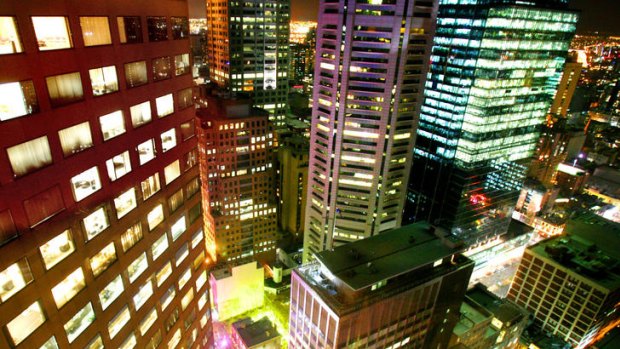This was published 12 years ago
Changes in green standards for buildings get serious
By Philip Hopkins
''GREEN building'' regulations get serious tomorrow, with building owners and even tenants facing potentially massive fines if their office space does not meet environmental standards when leased or sold.
The commercial building disclosure program - also known as mandatory disclosure - becomes fully operational from November 1. Under the program, a building energy efficiency certificate will be needed if more than 2000 square metres of office space is sold, leased or sub-leased. This applies to building owners and also tenants who sub-let the space.

Energy use in commercial buildings account for about 10 per cent of Australia's total greenhouse gas emissions.Credit: Craig Sillitoe
Failure to comply may result in fines up to $110,000 for the first day of non-compliance and up to $11,000 for each extra day.
A BEEC includes:
■A National Australian Built Environment Rating System energy star rating for the building.
■An assessment of tenancy lighting in the area that is being sold or leased.
■General energy efficiency guidance.
The NABERS criteria for BEEC includes an energy efficient rating with a scale of zero to six stars in half-star increments and a NABERS base building rating.
The tenancy lighting assessment provides a nominal lighting power density measurement in watts per square metre.
The NABERS Energy star rating must also be included in any advertisement for the sale, lease or sublease of the office space.
Minter Ellison partner Peter George warned that landlords faced impediments under the plan. ''The works will be capital in nature. They will not normally be able to be passed on to the tenant but the tenant will reap the benefit in lower energy costs,'' he said.
The consent of existing tenants was required because the work often entailed some disruption. ''Ideally the work should be carried out when the property is not tenanted, but in a multi-tenanted building, the lease terms are very unlikely to line up,'' he said.
''Even if the work is done, the tenant's fit out and general practices can have a big impact on the environmental credentials of the building.''
The 12-month transitional mandatory disclosure period when only a valid base or whole building rating was required ends tomorrow.
Governments will consider expanding the CBD program to other building types from next year.
By disclosing energy efficiency, the CBD program aims to give buyers and tenants access to meaningful information about a building's performance. This should make it easier for companies to buy or rent more energy efficient office space.
The aim is also to create a market-based incentive for owners to improve properties with cost-effective energy efficient upgrades.
Energy use in commercial buildings account for about 10 per cent of Australia's total greenhouse gas emissions.